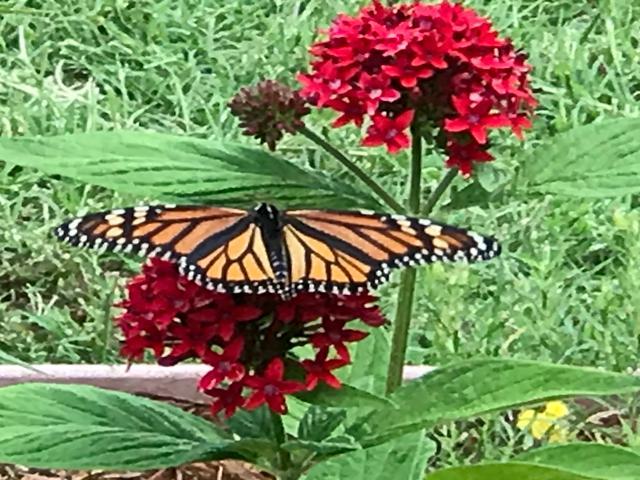
Date: 05/30/2018
Number: 1
At 5:05 p.m. on Wednesday, 5-30-18, a female monarch suddenly arrived in our garden. I was as delighted as I was surprised to see her given we’ve only seen 2 monarchs in our northwest Oklahoma City garden this spring both of whom were female, each of whom was reported to Journey North, respectively, on 4-30-18 and 5-3-18. This monarch remained until 7:45 p.m. intently nectaring the entire time on a single Pentas lanceolata plant’s flowers (aka Egyptian star flower). I was surprised by this behavior, because she had more nectar choices available to her, ranging from dozens of tall verbena blooms (V. bonariensis) and tropical milkweed (A. curassavica) to Echinacea pallida (pale coneflower) and cowpen daisy (Verbesina encelioides).
Her behavior was reminiscent of a migrator because of her single-minded, intently focused feeding. Considering we have 20 healthy milkweed plants growing in the garden areas, I can only conclude she is either one of the few first or second generation monarchs remaining this far south in very late May or that she hasn’t yet mated. Whatever the case, she was somewhat small and her scales were less vibrantly colored, traits which are consistent with first, second and third generation monarchs. Her wing condition was excellent and bore no signs of wear or damage; overall, she appeared healthy. She also displayed the robust aerial capabilities of her species and demonstrated no interest for feeding or laying eggs on any of the 20 milkweed plants available to her. (The milkweed species are: A. curassavica; A. syriaca; A. viridis; A. incarnata).
At the time of her arrival, the temperature gauge near the garden read 92 degrees; the relative humidity was 55%. The wind was from the SSW at 8 mph. When she departed to one of the nearby trees, it was 90 degrees and the wind was from the SW at 5 mph. Although we would welcome more monarchs to our garden and have available a sufficient number of host and nectar plants to support them, the early onset of late June heat in May would seem to discourage it, especially with future forecasts indicating we will remain on average 10 degrees above normal for this time of year and may even see the arrival of our first 100+ degree day as early as 6-5-18 if not sooner.
Oklahoma City, OK
Latitude: 35.6 Longitude: -97.6
Observed by: Denise
Contact Observer
The observer's e-mail address will not be disclosed.
Contact will be made through a web-based form.